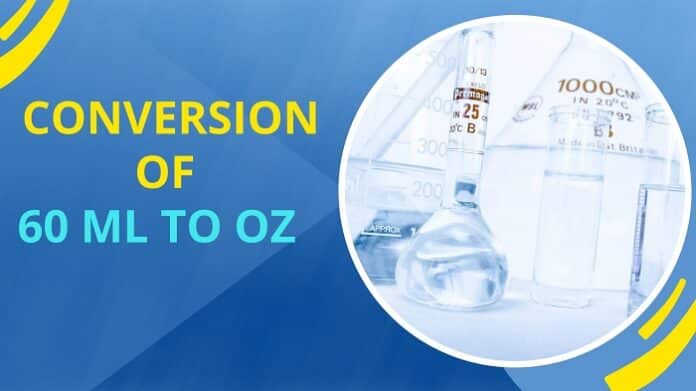Though they come from different parts of the world, milliliters (ml) and ounces (oz) are common units for measuring liquids. Commonly found in recipes, drink containers, and medicinal prescriptions, people employ the milliliter metric measures extensively outside of the United States. Conversely, ounces are more frequent in the United States, especially for liquid measures in recipes, retail goods, and many different businesses. Knowing the conversion between milliliters and ounces lets one measure more precisely. It’s more important when following international recipes, making drinks, or working in fields requiring exact proportions.
Milliliters to Fluid Ounces Converter
60 ml to oz and More
To convert milliliters to ounces, it’s useful to note that the US fluid ounce differs slightly from the UK fluid ounce. Here’s a quick breakdown:
- 1 US fluid ounce ≈ 29.5735 ml
- 1 UK fluid ounce ≈ 28.4131 ml
Using this conversion, we can calculate 60 ml in both US and UK fluid ounces.
60 ml to US fluid ounces:
Calculation: 60 ml ÷ 29.5735 ≈ 2.03 oz
60 ml to UK fluid ounces:
Calculation: 60 ml ÷ 28.4131 ≈ 2.11 oz
Therefore, 60 ml is approximately 2.03 US fluid ounces or 2.11 UK fluid ounces.
Conversion Table
For quick reference, here’s a table that converts ml values up to 60 into ounces for both US and UK measurements.
| Milliliters (ml) | US Fluid Ounces (oz) | UK Fluid Ounces (oz) |
| 1 ml | 0.03 oz | 0.04 oz |
| 2 ml | 0.07 oz | 0.07 oz |
| 3 ml | 0.10 oz | 0.11 oz |
| 4 ml | 0.14 oz | 0.14 oz |
| 5 ml | 0.17 oz | 0.18 oz |
| 10 ml | 0.34 oz | 0.35 oz |
| 20 ml | 0.68 oz | 0.70 oz |
| 30 ml | 1.01 oz | 1.06 oz |
| 40 ml | 1.35 oz | 1.41 oz |
| 50 ml | 1.69 oz | 1.76 oz |
| 60 ml | 2.03 oz | 2.11 oz |
This table offers a convenient reference for small liquid measurements, making it easier to convert ml to oz in settings like the kitchen, lab, or workshop.
Application of Oz Measurement Unit in Various Industries
Ounces are commonly used in several industries for measuring liquids, especially in regions where the imperial system is dominant. Here are some examples of how ounces are applied:
- Culinary and Beverage Industry
Particularly in the United States, ounces are used in recipes and drink measurements somewhat often. For cooking and baking, for instance, ounces are used to list soft drinks, wine, and spirits as well as other components. - Healthcare and Pharmaceuticals
Dose measures in the medical industry call for both ml and oz. Sometimes prescriptions for liquid drugs or baby formula call for ounces, which helps guarantee the correct dosage. - Cosmetics and Personal Care
Particularly in US-based businesses, many cosmetics—including lotions, shampoos, and perfumes—use ounces on their labels. This lets customers evaluate the quantity of the goods fast and make comparisons with like products. - Retail and Packaging
For home goods such as cleansers and other liquid-based products, packaging generally lists ounces, which makes it simple for buyers to select the appropriate quantity. - Chemicals and Industrial Applications
Industrial environments—especially for smaller volumes of chemicals, essential oils, or other liquids—where exact measures are vital for safety and quality control—use ounces.
End Note
Particularly when working with cross-cultural recipes, foreign product packaging, or any job requiring fluid measurement, knowing conversions like 60 ml to oz can be quite useful. Whenever necessary, you can quickly convert between ounces and milliliters using the conversion chart above and a fundamental knowledge of their differences. Not only are accurate conversions handy, but they also assist in guaranteeing consistency, safety, and quality in both personal and business environments.
FAQs
How many ounces is 60 ml?
60 ml is approximately 2.03 US fluid ounces or 2.11 UK fluid ounces.
Can I use a simple formula to convert ml to oz?
Yes, you can divide milliliters by 29.5735 to convert them to US ounces. For a rough estimate, dividing by 30 can give you an approximate value.
Why do different countries use ml and oz differently?
Countries that use the metric system, such as most of Europe, use milliliters, while the United States relies on the imperial system, using ounces for liquid measurements. This difference stems from historical measurement practices.





